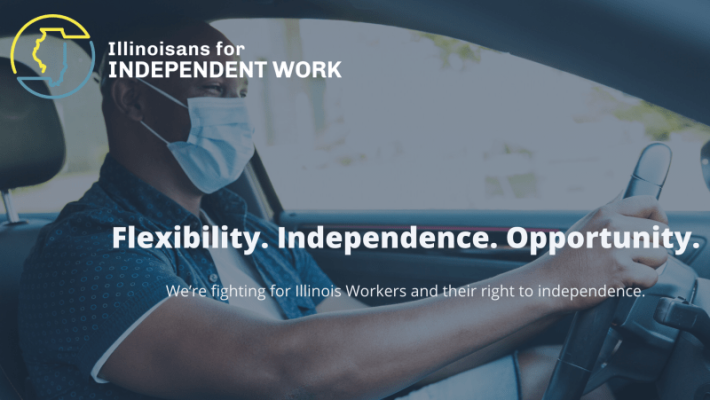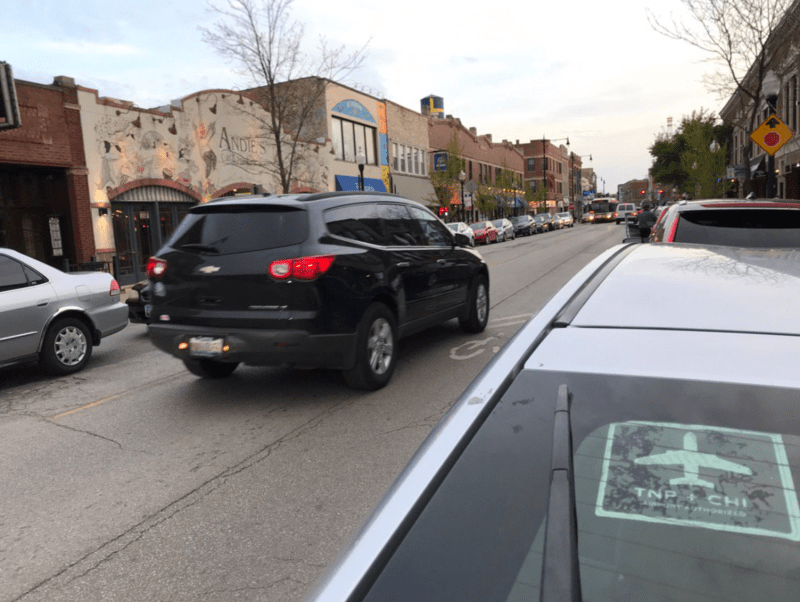Streetsblog Chicago has previously reported on the steep drop in transit ridership during the COVID-19 pandemic. I’ve been curious as to how Uber and Lyft has fared during this time. Researchers at the University of Illinois at Urbana-Champaign and the Illinois Economic Policy Institute were commissioned by the Project for Middle Class Renewal to study the effects of the COVID pandemic on ride-hail drivers in a report titled On-Demand Workers, Sub-Minimum Wages.
Researchers found that both the number of ride-hail passengers and the number of drivers fell considerably based on analysis of nearly 78,000 trips completed within Chicago during September 2019 and September 2020. Before the pandemic there were over 110,000 registered ride-hail drivers, 66 percent of whom (72,000) were active and recorded at least one trip during September 2019. In September 2020, there were fewer than 67,000 ride-hail drivers, 44 percent (29,000) of whom recorded at least one ride. Interestingly, the average number of trips by ride-hail drivers stayed consistent at a little over 120 rides per month.
According to the study’s co-author and PMCR’s director, Dr. Robert Bruno, “Total vehicle miles traveled with passengers fell by 63 percent from September 2019 to September 2020. We found that the average distance per trip fell by 5 percent but the average duration fell even further, indicating that drivers completed trips at a faster pace. In fact, the workers drove 16 percent faster because roads were more open.”
Given that researchers were analyzing wages earned by drivers, they looked at tips and take-home wages. The average customer tip decreased by nearly 40 percent and the share of trips that resulted in tips dropped from 21 percent to 14 percent. Ride-hail drivers typically make between $19 and $23 an hour before taxes and expenses. After taxes and expenses are accounted for, ride-hail drivers make below Chicago’s minimum wage. Analysis of 2019 wages for ride-hail drivers showed that they earned $12.30 an hour, below the $13 minimum wage in Chicago at the time. Drivers earned more in 2020, $15.09 an hour, but researchers argue the wage is “artificially inflated” due to reduced traffic congestion. Had traffic levels remained the same in 2020, drivers would have earned $13.62 per hour, 3 percent lower than Chicago’s current $14 an hour minimum wage.
According to researchers, a critical element at play with the wages of ride-hail drivers is their classification as independent contractors as opposed to employees. Currently companies like Uber and Lyft take a cut of the fare, somewhere between 20 and 28 percent for Uber and 20 percent for Lyft. Researchers argue that classifying ride-hail drivers as employees will lead to an increase in wages by requiring the companies to ensure that the drivers make at least the minimum wage.
Additionally, classifying ride-hail drivers as employees will provide full employment rights along with coverage under overtime pay laws, paid sick and family leave, unemployment insurance, and workers’ compensation. Despite ride-hail drivers being classified as independent contractors, unemployed ride-hail drivers have been eligible for Pandemic Unemployment Assistance. But this comes at a cost to Illinois taxpayers since Uber and Lyft do not pay into the unemployment insurance system. Classifying ride-hail drivers as employees would rectify that issue.
Short of classifying ride-hail drivers as employees, the licensing and regulatory framework of the city of Chicago's Transportation Network Providers Ordinance (the ordinance that regulates companies like Uber, Lyft, and Via) could be changed to require a minimum driver wage. The report states that the minimum wage of $15 an hour for ride-hail drivers would increase their earnings an average of by eight percent.
New York City and California offer two diverging paths on rights and wages for ride-hail drivers. In February 2019 New York implemented a minimum wage for drivers. According to the report, the policy in New York increased the average base passenger fare by 6 percent but resulted in an 8 percent increase in weekly pay for ride-hail drivers. Company commission rates also fell which researchers interpreted to mean Uber, Lyft, and other ride-hail companies absorbed the fare increase.

Voters in California voted yes on Proposition 22 in the November 2020 election. Propositions are binding referenda, placed on all California voters’ ballots after petitions attain a minimum number of signatures. Prop 22 established “app-based drivers” and delivery workers as independent contractors as opposed to employees. Streetsblog Chicago previously reported on a new Lyft-funded super PAC with the goal of preventing Illinois gig workers from receiving employee benefits.
Like it or not, ride-hail companies are part of the transportation landscape in Chicagoland. We would do well to classify ride-hail drivers as employees and ensure they earn fair wages and access to protection and coverage under employment laws.





